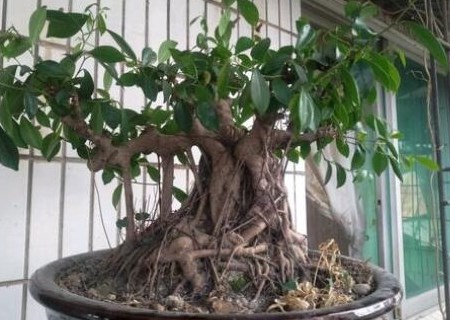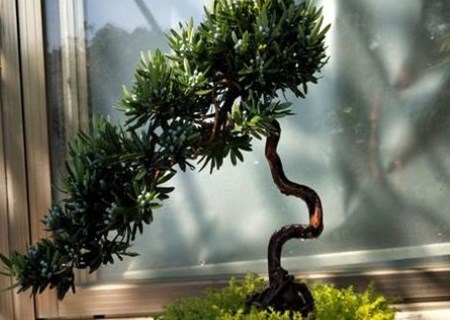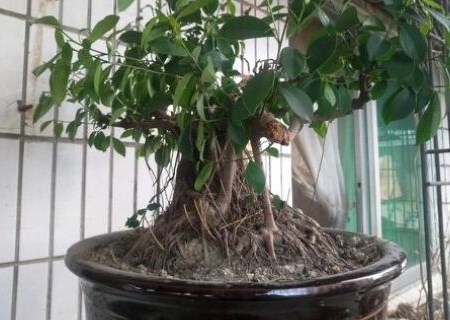What are the planting methods of Sankoh banyan bonsai? How to fertilize? What is the reason for the falling leaves?
Banyan bonsai is through pruning, pruning, hanging, grafting, careful cultivation, long-term control of its growth and development, making it a unique artistic shape of potted banyan bonsai. So do you know the planting methods of banyan bonsai? How to fertilize? What is the reason for the loss of leaves?

I. the planting method of banyan bonsai
1. Seedling selection and planting
Should choose and buy seedlings planted in a nutrition cup within a year, the stem is about 5 mm thick, 200 Mel 300 mm high, the lower part of the seedling stem has a lot of germinating lateral branches are better, too thick is not suitable for modeling, easy to break. The planting time should be from the end of March to early August, and the best time is from March to April.
It is better to use earthen pots with a caliber of about 35 cm, because plants need oxygen to grow. When the soil is poorly ventilated, due to the activity of anaerobic microorganisms, organic matter decomposes and emits carbon dioxide, which inhibits root respiration and affects growth. Therefore, the preparation of culture soil is very important, and it is also one of the prerequisites for rapid growth. Base fertilizer, retting for more than half a year before use, contains cinder waste mud, vegetable garden soil, one-third of each, mixed evenly, do not use cohesive soil planting. The seedlings can be soaked in 5-10ppm naphthylacetic acid solution or 5ppm indole butyric acid solution for half an hour before planting. When planting seedlings, fill three quarters of the culture soil in the pot first, tear off the nutrition bag, put the seedlings into the pot and pile up the culture soil, in order to cover the root surface of the seedling stem, do not fill, do not bury deeply, otherwise there are not many roots or produce double roots.
2. Modeling and cultivation
Styling is to achieve the goal of dwarfing, and it will be able to "see the big in the small" in the future. Styling is the most important link to determine whether there is ornamental value and economic value after the stump is set up. The general tree stump without ornamental or economic value after a few years of cultivation is a waste of time, manpower and material resources, and dampens the enthusiasm. Generally, the modeling work can be carried out within 20 to 45 days, and the metal wire can be used to climb according to the pile shape that everyone likes. No matter what kind of pile, but there is one principle: music is beautiful. First in the big S-bend to build a few waves or before and after the wrong, and then a small S-bend, do not forget that there are also several waves, rich in change, not balanced, similar on it. Take more care and cut carefully. The first year can not be cut, only the bottom side branches (floating branches) or rear support branches can be properly clamped and reshaped, which can shorten the forming time. When growing to a height of about 50 cm in the second year, you can control the top of the trunk to control "topping" (that is, ultra-high cutting) to facilitate the thickening of the lower transverse branches, to enlarge the stem, to trim some horizontal branches after growing up in the third and fourth years, to control the plant type, and to pay attention to the top and end of the trunk. In the fifth year, the first stem is at least about 8 cm, and the lateral branches and rear support branches can basically be cut on two to three paths, and the stump is basically shaped. Watering and fertilizing is a long-term task. After three months of planting, the seedlings began to enter the growth period, which can supply chemical fertilizer water (dissolve the chemical fertilizer in the small) to supplement the nutrients needed for the rapid growth of banyan seedlings, with particular emphasis on the application of potassium chloride, followed by urea. Potassium dihydrogen phosphate and urea were applied at the same time, and the second year was the peak period of banyan growth, with trunk and strong transverse branches. After a year of cultivation and use of limited basin soil, nutrient consumption and massive loss, a layer of 2Mel 4cm thick base fertilizer should be spread along the basin surface, and peanut bran fertilizer or chemical fertilizer should be applied immediately after rain and sunny days (peanut bran can only be used for half a month). Watering and fertilization cannot be done mechanically, but can be implemented according to people's free time, cultivation techniques, geographical environment and climate change.
3. Growth regulators and the use of trace elements
In order to promote root regeneration and accelerate growth, some growth regulators such as 20ppm naphthalene acetic acid solution or 2x4D solution, indole butyric acid solution and indole butyric acid solution are properly used from May to September every year, and the concentration of 10ppm920 spray leaf surface should be reduced by 1/3 in midsummer. The above regulators are applied after 4: 00 p. M. on a sunny day, and the effect is good when the temperature is 18-25 degrees. After the second year, it needs to be supplemented every year: ferrous sulfate, copper sulfate, zinc sulfate, magnesium sulfate, manganese sulfate, ammonium molybdate, boric acid and other trace elements nutrient solution twice, the total concentration can not exceed 0.4%, can also be foliar spray, the concentration is 0.05mol 0.1%.
4. Pest control
The banyan tree can not change the basin frequently, and there is generally no disease if the root injury is not serious. after changing the pot, you can smear the cut or wound with purple potion or low concentration potassium permanganate solution. There are relatively few insect pests, mainly caused by thrips. Spraying pesticides after this insect damage is not effective, mainly to prevent. From the beginning of summer to the end of autumn every year, methamidophos is sprayed once to twice every month. The concentration of methamidophos: water = 1: 200, combined with the release of carbofuran, buried in the soil is significant. Agricultural medicine is strong, clear pay attention to safety.
2. How to apply fertilizer to banyan bonsai
The potted soil of banyan bonsai is limited, so we should pay attention to the supplement of fertilizer at ordinary times. During the growing period of banyan trees in summer and autumn, rotten cake fertilizer and water are applied once a month, with little or no fertilization in winter. In addition, when changing the basin once every two years, the organic fertilizer will be crushed and matured according to a certain proportion, mixed into the basin to provide nutrition slowly.
Quick-acting fertilization is to dilute organic fertilizer or chemical fertilizer, according to the seasonal growth of the stump needs to fertilize, but should not be too thick, the newly planted stump is not suitable for this kind of fertilization, fertilization in rainy days, fertilizer loss, the effect is not good.
The growth of banyan is fond of fertilizer, but more times of fertilization will cause harm to the growth of banyan. The amount of fertilizer varies from season to season.
Although the banyan tree likes fertilizer, it can be applied more than 10 grains of compound fertilizer every month. Pay attention to burying the fertilizer into the soil along the edge of the flowerpot when applying fertilizer, and water it immediately after fertilization. The main composition of fertilizer is nitrogen, phosphorus and potassium.
After the stump entered the normal nursing, the rotten human and animal feces and urine or compost cake fertilizer were used as topdressing and applied outside the root once or twice a day.
When transplanting or changing pots, you can also use cooked chicken dung, bean cake and bone powder mixed with culture soil as base fertilizer. Sufficient fertilizer will make the branches grow faster and thicker, and can be pruned more times a year, so as to shorten the culture period.
During the growth period of summer and autumn, mature cake fertilizer is applied every 15 days, and potassium dihydrogen phosphate can be sprayed at the same time. Compound fertilizer and granular fertilizer can be selected for family maintenance and fertilization. The method is to apply thin fertilizer frequently, grasp the fertilization season and stop fertilization in winter.
It should be noted that the fertilization of banyan trees should be carried out by applying thin fertilizer frequently to avoid the application of high concentration chemical fertilizer or unfermented mature organic fertilizer, otherwise it will cause fertilizer damage, the light ones will lose their leaves and the heavy ones will die.
Third, what is the reason for the loss of leaves in banyan bonsai
1. Improper watering
The banyan tree likes the wet environment, the basin soil is too dry will appear the defoliation phenomenon. Of course, there is one of the most serious, that is, three days of fishing, two days of watering flowers, watering depends on the mood, this kind of people are not good banyan trees, fallen leaves is just a small warning to you.
Solution: in fact, the root system of the banyan tree is very developed, and it will not do much harm to dry the soil in a short time, if you go too far, it is hard to say. After not giving water and falling leaves for more than a month, do not flood at one time, but step by step and water little by little, otherwise it is easy to cause poor root growth.
2. Improper fertilization
Excessive fertilization causes fertilizer damage and affects the growth of the plant. if it is light, the leaves will fall and if it is heavy, it will die.
Solution: fertilization should be in accordance with the method of frequent application of thin fertilizer, to avoid the use of high concentration chemical fertilizer or unmature organic fertilizer. Water in time the next day after fertilization to dilute the fertilizer in the basin soil. If you apply too much fertilizer, you can use the method of watering to let the excess fertilizer flow out from the bottom of the basin with the water, and then dry the basin soil.
3. Lack of light
The leaves of banyan trees are luxuriant and need more nutrients to support, and the important source of these nutrients is sunlight. When the light is insufficient, the leaves grow badly and the leaves fall. Of course, in the muggy summer environment, the leaves will fall due to excessive light.
Solution: adjust the light time according to seasonal changes, strong light in summer, 50% shade at noon, normal light in other seasons, and no shade when the temperature is lower than 32 ℃.
4. Diseases and insect pests
The common pests of banyan trees are shell insects and red spiders, which are easy to appear in the environment of poor ventilation and dry air.
Solution: wash the worms with water and spray mites with insecticides. Or choose laundry powder or wind oil essence to spray, non-toxic, the prevention and control effect is very good.
Time: 2019-03-17 Click:
- Prev

How to trim the bonsai of Luohansong? How to control leaf blight?
Luohan pine bonsai, its green new leaves dotted among the thick green leaves, the posture is simple and elegant, quite beautiful, is a kind of excellent bonsai production material. So do you know how to trim the bonsai of Luohansong? How to control leaf blight? How to trim and shape the bonsai of Luo Han Song
- Next

How to shape the banyan bonsai? How should it be trimmed? How much is it per pot?
Because of the long-term control of its growth and development, the banyan bonsai has become a unique artistic bonsai. So do you know how to shape the banyan bonsai? How should it be trimmed? How much is it per pot? How to shape the banyan bonsai? 1.
Related
- Fuxing push coffee new agricultural production and marketing class: lack of small-scale processing plants
- Jujube rice field leisure farm deep ploughing Yilan for five years to create a space for organic food and play
- Nongyu Farm-A trial of organic papaya for brave women with advanced technology
- Four points for attention in the prevention and control of diseases and insect pests of edible fungi
- How to add nutrient solution to Edible Fungi
- Is there any good way to control edible fungus mites?
- Open Inoculation Technology of Edible Fungi
- Is there any clever way to use fertilizer for edible fungus in winter?
- What agents are used to kill the pathogens of edible fungi in the mushroom shed?
- Rapid drying of Edible Fungi

